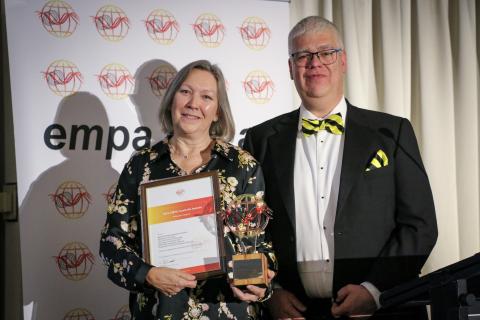


Two community-centred projects were recognised for excellence in emergency communication at the 2024 Emergency Management and Public Affairs (EMPA) Conference in Canberra in June.
The research conducted at Natural Hazards Research Australia (the Centre) prioritises impact and research use. The Centre is proud that its research is being recognised as making a meaningful difference in community resilience and disaster risk mitigation.
EMPA Australia 2024 Awards for Excellence in Emergency Communications – Research
Winner: Community experiences of the 2022 Australian floods – Queensland and New South Wales by A/Prof Mel Taylor (Macquarie University/DCCEEW), A/Prof Fiona Miller (Macquarie University), Prof Kim Johnston (QUT), A/Prof Anne Lane (QUT), Dr Barbara Ryan (University of Southern Queensland), A/Prof Rachel King (University of Southern Queensland), Dr Harriet Narwal (Macquarie University), Madeleine Miller (Macquarie University), Dr Dipika Dabas (University of Southern Queensland) and Helga Simon (Macquarie University), with support from Michael Carroll (Queensland Fire and Emergency Services) and Heather Stuart ESM (NSW State Emergency Service), alongside Nicola Moore and Dr Kat Haynes (Natural Hazards Research Australia).
The research team from Queensland and New South Wales won the award in the Research category for their study on the community experiences during the 2022 Australian floods. The research focused on gathering personal stories from individuals affected by the extreme flooding along the Australian east coast. The research gained a deeper understanding of the impact on these individuals and families and was largely exploratory and participant-led, with the researchers gently guiding the conversations to allow the participants to discuss issues important to them.
Conducted through a large mixed-method, post-event study, the research findings are utilised by government, emergency services and other groups to offer guidance and shape strategies for enhancing flood safety and community resilience at a national level. This includes preparedness and response, as well as long-term adaptation. This post-event research utilised a trauma-informed approach and comprised of interviews and a shorter online survey to gather data. Key areas investigated were preparedness, community risk awareness and engagement with emergency response agencies. The research depended on inter-agency collaboration and strong partnerships with stakeholders to ensure the project was successful and the findings useful, useable and used.
A/Prof Mel Taylor accepted the award on behalf of the team.

Photo: A/Prof Mel Taylor and EMPA Co-chair Sam Rossiter-Stead
EMPA Australia 2024 Awards for Excellence in Emergency Communications - Community Engagement
Winner: Schools in Fire Country by Dr Briony Towers (Leadrrr), Neil Munro (CFA/Safer Together), Harkaway Primary School, the Department of Energy, Environment and Climate Action.
Dr Briony Towers, Neil Munro and the Schools in Fire Country team from Harkaway Primary School and the Department of Energy, Environment and Climate Action took out the Community Engagement award for the establishment of an education program that puts children at the heart of bushfire risk management in their local area.
Schools in Fire Country is a place-based, curriculum-aligned bushfire education program for Victorian upper primary school students. Built on evidence-based approaches and multi-agency, cross-sector collaborative partnerships, the program empowers students with the knowledge and skills they need to navigate the complexities of bushfire risk management in their households, schools and communities.
The initiative has been so successful that additional schools in Victoria are now implementing the Schools in Fire Country program, while federal funding from the National Emergency Management Agency has been received to further build capability and capacity for scalable and sustainable implementation.
The transdisciplinary curriculum design integrated learning areas across science, mathematics, the arts, humanities and social sciences, design and technology. This provided students with a holistic understanding of bushfire hazards and risks as they co-designed the resources and improved practical application.
Centre Communications Manager, Nathan Maddock accepted the award on behalf of the team.
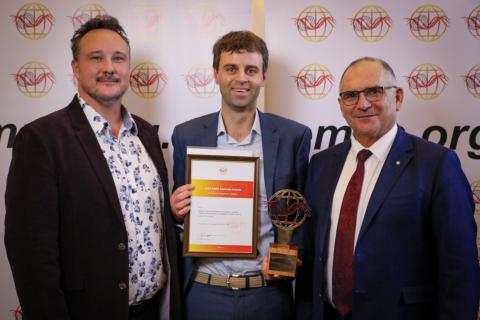
Photo: EMPA Co-chair Jeremy Hillman, Nathan Maddock and NEMA Deputy Coordinator-General Joe Buffone
The Centre’s research is truly collaborative and is only possible due to the involvement of many people, organisations and communities in both of these projects: the research teams; project management committee members; Participants who advocated for and supported these projects; community members who shared their experiences of flood in NSW and Queensland; and Harkaway Primary School students and teachers, who are all recipients of these awards. Thank you!
Fellowships recognise achievement
Congratulations to our very own researcher A/Prof Mel Taylor and Communications Manager Nathan Maddock, who were both awarded EMPA Fellowships. The Fellowships recognise Mel and Nathan’s long-standing dedication to EMPA and emergency communications in Australia.
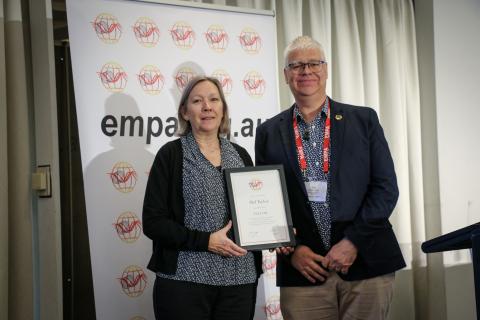
Photo: A/Prof Mel Taylor and EMPA Co-chair Sam Rossiter-Stead
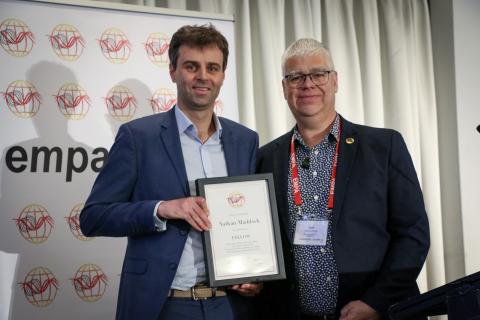
Photo: Nathan Maddock and EMPA Co-chair Sam Rossiter-Stead
Presentations from Centre researchers
The conference also featured plenty of Centre research, with two talks to the audience of emergency management communications and community engagement professionals from around Australia.
Neil Munro (CFA/Safer Together) presented on the Schools in Fire Country program, sharing how a child-centred approach to disaster risk reduction is empowering upper primary school kids to take charge of bushfire planning in their schools, homes and communities. Neil covered the collaborative process of developing Schools in Fire Country and its successful outcomes that are now being implemented further in additional schools in Victoria.
Communicating bushfire risk with maps was the focus of a presentation from Dr Erica Kuligowski (RMIT University) and Dr Paula Dootson (Queensland University of Technology) from the Predictions in public project. Erica and Paula shared findings from their research into how people understand bushfire prediction and incident maps, with key findings showing that people under threat from a bushfire want bushfire maps to know the locations of fire activity and give a clear indication of the direction of fire spread.
Both presentations were well received and sparked a strong follow-up discussion with EMPA delegates.
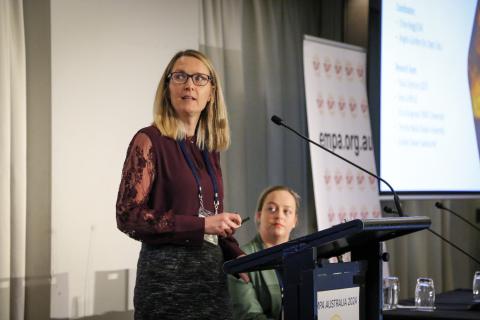
Photo: Dr Erica Kuligowski and A/Prof Paula Dootson
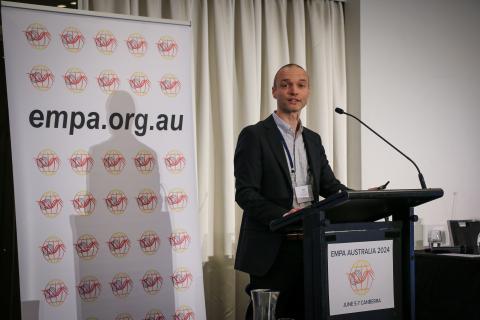
Photo: Neil Munro